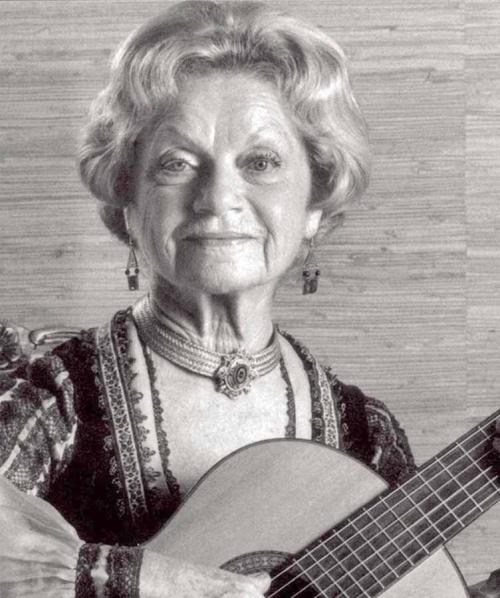
This post is by library technician Rachel Evangeline Barham.
Did you know that one of Hanukkah’s most influential tastemakers lives in the DC area? The multifaceted musician Flory Jagoda, now in her 90s, calls Virginia home. She is known widely as the “keeper of the flame” of the music of Bosnian Sephardic Jews.¹ Here she is sharing one of her most famous songs, the counting song “Ocho Kandelikas” (Eight Candles). (Warning: it’s catchy!) I use the word “sharing” because – you’ll agree when you see her – it is clear that Flory Jagoda is not just performing the music she composed. Sharing her music is her way of transforming unthinkable personal and collective tragedy into a living monument to the special family who raised her and who were robbed of their own lives.
Flory Jagoda was born into the Altarac Singing Family of Vlasenica, Bosnia: her mother and seven aunts and uncles – directed by Flory’s Nona (grandmother) – sang and played instruments at all kinds of public gatherings.² Flory lived with her Nona until she was eleven years old, speaking Ladino (or Judaeo-Spanish), the language that Sephardic Jews took with them all over the world after Ferdinand and Isabella’s 1492 Edict of Expulsion. Both the Ladino language and its songs preserve parts of medieval Spanish but have picked up local flavor wherever people settled: a new spelling of a word here, a new instrument there. Flory’s Nona was an eager teacher of a very willing pupil, passing on all the songs she knew to her granddaughter.

It was when she had to leave her Nona and move to the city – against her will – that Flory’s stepfather gave the unhappy girl the accordion that would later save her life. Flory became adept at several instruments and adjusted to city life in Zagreb, but her world fell apart in 1941 when the Nazis’ racial policies hit her family hard. They managed to get to the Dalmatian island of Korchula, where they were interned for two and a half years before fleeing to Italy amid the chaos that accompanied the end of World War II in Europe. She found a job as an interpreter for the US Army in Italy, where she fell in love with and married a Jewish American soldier, Harry Jagoda. It was when they returned from their honeymoon that she learned to her horror that out of the 41 members of her beloved Altarac family, only her mother, one uncle, and one cousin had survived. Along with every other Jew left in Vlasenica, the family members were rounded up and brutally slaughtered on May 6, 1942. “Babies, Nona, Nonu, las tiyas (aunts), lus primus ermjanus (cousins) … all of them.”³

In 1946, Harry and his new wife settled in Virginia and started a family. For years, Flory, noting that silencing the past is a way of coping for many survivors, suppressed memories of her former life. But at some point, she wanted her children – and the world – to share the music, memories, and traditions that had made her childhood so special. She began recording music in the 1980s, releasing three albums and an accompanying songbook including both traditional songs and original compositions such as the joyful “Hanuka, Hanuka,” performed here by the Trio Sefardi, with whom Flory appeared in a 2013 interview with WAMU’s Kojo Nnamdi. Always a teacher, she has used her many public appearances to teach this music to anyone who will listen. Many of Flory’s songs are holiday-themed. “Because every holiday song … that I have composed continues the memory of my family in Vlasenica; I am still sharing the holidays with them.”⁴ Through her music, the legacy of an extraordinary musical family will live on from generation to generation.
Hear Pink Martini’s cover of “Ocho Kandelikas,” or this one by Flory’s great-grandchildren.
¹http://washingtonjewishweek.com/5670/a-keeper-of-the-flame-performs-at-library-of-congress/arts/ and many other sources.
²Much of Flory Jagoda’s life is well documented, but a particularly detailed first-person account of her family and personal history is found in the Introduction to The Flory Jagoda Songbook (Tara Publications, 1993). Many of the facts in that account are noted in this post.
³The Flory Jagoda Songbook, p.14.
⁴The Flory Jagoda Songbook, p.16.
